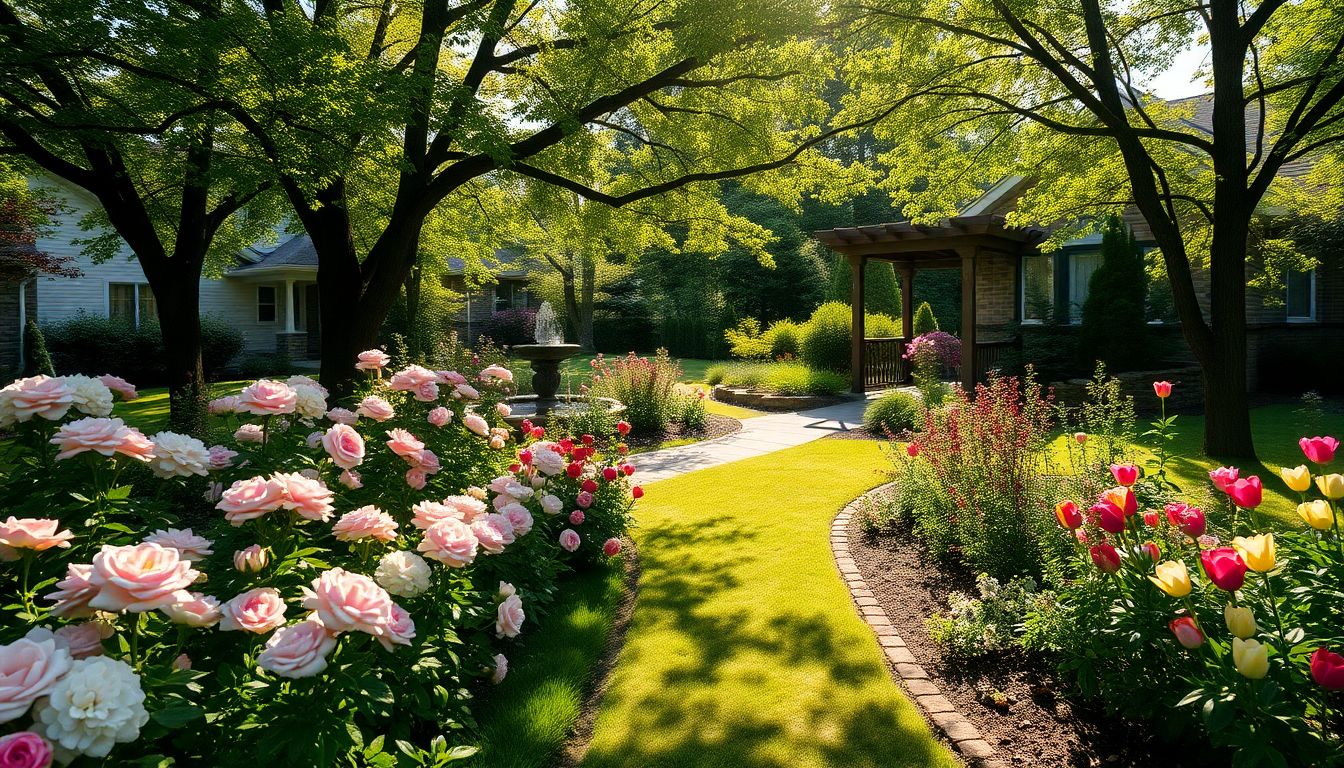
Imagine coming home after a long day to a lush garden. A green space that invites relaxation, with colorful flowers, shade-giving trees, and cozy corners for peaceful moments. That’s the power of well-planned residential landscaping.
Sadly, many homes face a different reality: neglected yards, undefined outdoor areas, or gardens needing constant upkeep without delivering the desired payoff. Recent studies show that investing in backyard design can boost your property value by up to 20% and cut energy costs by 25% through smart tree placement.
In this complete guide, you’ll learn how to transform your outdoor space into a personal oasis, blending beauty, function, and sustainability with residential landscaping. We’ve packed it with practical tips—from initial planning to maintenance—for gardens of all sizes and budgets.
1. Essential Planning: The Foundation of Successful Residential Landscaping
A dream garden doesn’t happen by chance. Careful planning is the bedrock of any successful backyard design. Follow these key steps to ensure the final result meets your expectations and needs.
Assessing Your Space and Family Needs
Before buying plants or hiring help, take a close look at your property:
- Size and Terrain: Measure the available space and note slopes or uneven areas.
- Soil Type: Sandy, clay, or balanced? Each requires specific care.
- Sun Exposure: Map full-sun, part-shade, and shaded spots throughout the day.
- Drainage: Watch how water flows after heavy rain.
- Fixed Features: Locate pipes, wiring, and structures that can’t be moved.
Also, think about how your family will use the space:
- A play area for kids?
- An outdoor kitchen for entertaining?
- A quiet reading nook?
- A veggie patch for homegrown produce?
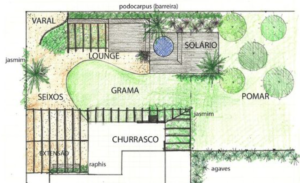
Defining Style and Setting a Realistic Budget
Residential landscaping offers endless style options. Popular choices include:
- Tropical: Lush, colorful, and vibrant with plants like heliconias, bromeliads, and palms.
- Contemporary: Clean lines, geometric shapes, and structured plants.
- Mediterranean: Inspired by Italy, Spain, and Greece with lavender, olive trees, and cypress.
- Japanese: Minimalist and serene, featuring rocks, water, and plants like maples and bamboo.
- Cottage Garden: Romantic and casual, bursting with flowers and herbs.
Budgets for backyard design vary widely:
- Basic: $10-30/sq ft (mostly planting and minor tweaks).
- Mid-Range: $30-60/sq ft (includes some hardscaping and irrigation).
- Full-Scale: $60-160/sq ft or more (with water features, advanced lighting, and premium materials).
Pro Tip: “Set aside 10% of your budget for surprises and prioritize infrastructure like drainage and irrigation—tough to fix later.” – Ana Luiza Petersen, landscaper with 15 years of experience.
Crafting a Detailed Plan: Pro or DIY?
A well-documented backyard design is your roadmap to success. You’ve got two paths:
Hiring a Professional Landscaper
Benefits:
- Expertise in plants and materials.
- Creative solutions for tricky spaces.
- Access to specialty suppliers.
- Detailed plans that streamline execution.
Professional fees typically range from 5-15% of the total project cost but can save big on mistakes and rework.
DIY Design
If you’re designing yourself:
- Use garden design apps like iScape or Home Design 3D.
- Build a moodboard with visual inspo.
- Draw a scaled map of your yard.
- Research plants thoroughly.
- Study garden design basics via books or online courses.
Either way, your plan should cover:
- Scaled layout.
- Full plant list.
- Material specs.
- Irrigation and drainage systems.
- Lighting.
- Timeline.
2. Choosing the Perfect Plants: The Heart of Your Residential Landscaping
Picking the right plants is key to thriving residential landscaping. Well-chosen plants need less care, save water, and build a balanced ecosystem.
Native vs. Exotic Plants: Striking the Right Balance
Native plants evolved in your region naturally. Their perks:
- Better suited to local climate and soil.
- Need up to 60% less water.
- Resist pests and diseases naturally.
- Attract pollinators and beneficial wildlife.
- Support local biodiversity.
Great native Brazilian plants for backyard design:
- Ipê (Handroanthus spp.) – stunning flowering tree.
- Manacá-da-serra (Pleroma mutabilis) – shrub with color-changing blooms.
- Quaresmeira (Tibouchina granulosa) – mid-size tree with purple flowers.
- Caliandra (Calliandra brevipes) – shrub with pom-pom flowers.
- Heliconia (Heliconia spp.) – tropical plant with bold blooms.
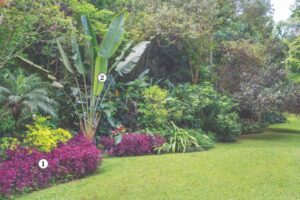
Exotic plants (from other regions) can enhance your garden with:
- Visual and textural variety.
- Blooms across different seasons.
- Unique design elements (like agaves or succulents).
Caution: Avoid invasive exotics that could escape and harm local ecosystems. Check invasive species lists before choosing.
Climate and Soil Factors: Right Plant, Right Place
Your backyard design thrives when plants match their spot:
Soil Analysis
Consider a soil test (available at garden stores or via agronomists) to check:
- pH (acidity/alkalinity).
- Texture (sand, silt, clay mix).
- Nutrient levels.
- Organic matter.
Use the results to:
- Pick plants suited to current conditions.
- Fix specific soil issues.
- Group plants with similar needs.
Sun Exposure Zones
Map your yard by sunlight:
- Full Sun: 6+ hours direct sun (great for roses, lavender, most succulents).
- Part Shade: 3-6 hours sun (ideal for hydrangeas, begonias, hardy ferns).
- Shade: Under 3 hours sun (perfect for ferns, philodendrons, peace lilies).
Expert Tip: “Track your yard’s light at different times and seasons. Sun exposure shifts a lot between summer and winter, especially in southern areas.” – Carlos Eduardo Oliveira, agronomist.
Flowers, Shrubs, and Trees: Building a Balanced Look
A well-planned garden mixes plant types for visual appeal and utility:
Layering Principle
Arrange plants in layers:
- Top Layer: Trees for structure, shade, and bird habitat.
- Middle Layer: Shrubs for volume, privacy, and transitions.
- Bottom Layer: Groundcovers, herbs, and flowers for color and texture.
Seasonal Composition
Choose plants for year-round interest:
- Spring: Yellow ipês, manacás, azaleas.
- Summer: Allamandas, hibiscus, plumbago.
- Fall: Quaresmeiras, mignonettes, cassias.
- Winter: Camellias, cyclamens, fuchsias.
Harmonious Pairings
Proven combos for residential gardens:
- Lavender + Rosemary + Lantana (low-maintenance, pollinator-friendly).
- Areca Palm + Heliconia + Maranta (tropical mix for shade).
- Poet’s Jasmine + Gardenia + Hydrangea (fragrant part-shade trio).
- Yellow Ipê + Manacá-da-serra + Caliandra (native height mix).
3. Design Elements for Cozy Residential Landscaping
Beyond plants, built and decorative features make a garden functional and inviting. They define spaces, ease movement, and add character to your backyard design.
Paths, Patios, and Decks: Welcoming Functional Spaces
These structural elements form your garden’s “architecture”:
Paths and Walkways
Well-planned paths guide guests, protect plants, and boost charm:
- Popular Materials: Flagstone, concrete pavers, gravel, brick, wood.
- Ideal Width: 32-48 inches for main paths; 24-32 inches for secondary.
- Design: Curved paths feel natural; straight ones look formal.
Creative Idea: Make stepping stones with concrete slabs molded with large leaves like elephant ears for a custom touch.

Patios and Seating Areas
Paved spots create “outdoor rooms” for dining, relaxing, and socializing:
- Sizing: At least 10×10 ft for a small table and chairs.
- Materials: Outdoor porcelain, natural stone, stamped concrete, wood decking.
- Best Spot: Near the house, with garden views and wind protection.
Decks and Pergolas
Elevated structures for unique vibes:
- Decks: Great for uneven terrain or raised platforms.
- Pergolas: Offer partial shade and support for climbers.
- Sustainable Materials: Certified wood, composite decking, treated bamboo.
Maintenance Tip: “For wood decks, apply an outdoor sealant every 12-18 months. It extends lifespan and keeps the natural look intact.” – Marcelo Santos, outdoor carpentry expert.
Landscape Lighting: Enhancing Nighttime Beauty and Use
Lighting transforms your garden after sunset, creating magic and extending enjoyment:
Types of Garden Lighting
- Path Lighting: Low bollards or in-ground fixtures.
- Uplighting: Spotlights to highlight trees, sculptures, or structures.
- Ambient Lighting: Soft glow for a cozy vibe.
- Task Lighting: Brighter for active areas like grills.
Efficient Tech
Choose energy-saving options:
- LED: Uses up to 80% less power than traditional bulbs.
- Solar: Perfect for spots without wiring.
- Smart Systems: Motion sensors and timers cut usage.
2023 Trend: Smart lighting controlled via apps, letting you switch garden “scenes” with a tap.
Water Features: Bringing Life to Your Garden
Water elements add a sensory layer to residential landscaping with soothing sounds, reflections, and wildlife appeal:
Options for All Spaces and Budgets
- Reflecting Pools: Calm surfaces mirroring sky and plants.
- Fountains: From small units to elaborate setups.
- Waterfalls: Add motion and relaxing sound.
- Rain Gardens: Planted dips to catch runoff.
- Birdbaths: Simple wildlife attractors.
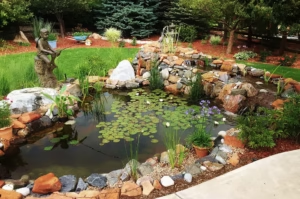
Practical Tips
Before adding water features, consider:
- Proper waterproofing.
- Water filtration and circulation.
- Safety (especially with young kids).
- Maintenance needs.
- Water and power use.
Eco-Friendly Fix: “Closed-loop systems with solar pumps cut energy use. Aquatic plants like water hyacinth and papyrus naturally clean water, reducing chemical needs.” – Patrícia Mello, water garden specialist.
4. Maintenance and Care: Ensuring Lasting Garden Beauty
A well-planned garden cuts upkeep, but all green spaces need regular care. Smart routines keep your residential landscaping investment thriving for years.
Smart Watering and Conservation: Efficient Strategies
Irrigation can account for 70% of garden water use. Optimize it:
Efficient Watering Systems
- Drip Irrigation: Saves up to 60% water vs. sprinklers.
- Micro-Sprinklers: Great for larger areas with leaf-loving plants.
- Smart Irrigation: Weather-adjusted controllers.
Water-Saving Practices
- Mulching: Organic ground cover cuts evaporation by up to 70%.
- Hydrogel: Water-retaining polymers for slow root release.
- Rainwater Harvesting: Cisterns or barrels off gutters.
- Plant Grouping: Cluster plants with similar water needs.
Best Time: Water early (5-9 AM) to reduce evaporation and fungal issues. Skip midday heat or nighttime.
Pruning and Fertilizing: Boosting Healthy Growth
Basic care keeps your garden vigorous and neat:
Pruning Techniques
Different plants, different cuts:
- Shaping: Guides young trees and shrubs.
- Cleaning: Removes dead, sick, or crossing branches.
- Bloom Boost: After blooming for old-wood plants; pre-spring for new-wood.
- Topiary: Artistic shaping.
Plant Nutrition
A solid feeding plan keeps plants strong:
- Organic Fertilizers: Compost, worm castings, castor cake (slow-release, soil-building).
- Chemical Fertilizers: NPK tailored to plant needs.
- Timing: Every 2-3 months in spring/summer; 3-4 in fall/winter.
Simple Schedule: “Set a seasonal plan. Spring: fertilize and pest control. Summer: water and light trims. Fall: heavier pruning and winter prep. Winter: minimal upkeep.” – Roberto Burle Marx Neto, landscaper.
Pest and Disease Control: Prevention and Fixes
Healthy gardens resist issues naturally. Use an integrated approach:
Prevention First
- Pick climate-suited plants.
- Space for airflow.
- Water wisely (avoid excess moisture).
- Remove sick leaves fast.
- Attract natural predators with natives.
Natural and Chemical Control
Start gentle, escalate if needed:
- Manual: Hand removal, traps, barriers.
- Biological: Beneficial predators, bacteria.
- Homemade: Tobacco rinse, neem oil, diluted coconut soap.
- Organic Products: Certified for organic use.
- Synthetics: Last resort, per instructions.
Regular Checks: “Scan your garden weekly, focusing under leaves and new growth where trouble starts. Early detection means easier, gentler fixes.” – Dr. Lúcia Kawasaki, entomologist.
5. Sustainable Landscaping: Eco-Friendly Gardens
Sustainable landscaping goes beyond looks, conserving resources, boosting biodiversity, and enhancing well-being. Demand for eco-friendly designs has surged 35% in the past two years.
Low-Maintenance Gardens: Beauty with Less Effort
Low-upkeep designs are trending:
- Xeriscaping: Cuts irrigation needs.
- Wildflower Meadows: Alternatives to lawns.
- Perennials: No annual replanting.
- Groundcovers: Suppress weeds naturally.
Low-maintenance plants for warm climates:
- Agaves and assorted succulents.
- Peanut Grass (Arachis repens).
- Peace Lily (Spathiphyllum wallisii).
- Ixora (Ixora coccinea).
- Dracaenas (Dracaena spp.).

Edible Gardens: Functional Beauty
Mixing edibles into residential landscaping merges style and utility:
- Ornamental Veggie Beds: Veggies, herbs, and edible flowers.
- Herb Gardens: Aromatic and kitchen-ready.
- Compact Orchards: Dwarf fruit trees or espaliers.
- Agroforestry Systems: Trees, shrubs, and herbs in productive layers.
Bonus: “Edible gardens can cut veggie and herb costs by up to 30%, offering pesticide-free food with a tiny carbon footprint.” – Brazilian Permaculture Institute.
Biodiversity Gardens: Welcoming Wildlife
Turn your yard into a wildlife haven:
- Pollinator Plants: Lantanas, milkweed, salvias.
- Bird Feeders and Baths: Attract feathered friends.
- Insect Hotels: Shelters for ladybugs, solitary bees, and beneficial bugs.
- Small Ponds: Homes for frogs and dragonflies.
- Log Piles: Refuges for small critters and fungi.
A diverse garden isn’t just pretty—it’s tough. Variety curbs pest outbreaks and builds a self-sustaining ecosystem needing less work.
6. Landscaping for Small Spaces: Maximizing Compact Areas
Apartments, townhouses, and tiny urban lots deserve greenery too. Landscaping for small spaces calls for creativity and smart planning.
Vertical Gardens: Making Use of Walls
When floor space is tight, go up:
- Modular Systems: Pre-made panels with plant pockets.
- Trellises and Frames: For climbing plants.
- Tiered Shelves: For pots and planters.
- Recycled Pallets: Turned into vertical gardens.

Top Plants for Vertical Gardens:
- Ferns (various types).
- Peperomias (Peperomia spp.).
- Columneas (Columnea spp.).
- Pothos (Epipremnum aureum).
- Staghorn Fern (Platycerium bifurcatum).
Balconies and Patios: Urban Retreats
Turn these spots into green escapes:
- Pots and Planters: Pick lightweight ones with water reservoirs.
- Multi-Use Furniture: Benches with plant storage, tables with built-in planters.
- Light Pergolas: For shade and climber support.
- Green Curtains: Hanging plants for privacy.
Key Note: “For balconies and patios, check structural load limits before adding heavy pots or water features. Use light substrates like coconut fiber and perlite.” – Renato Mendes, structural engineer.
Miniature Gardens: Terrariums and Kokedamas
For super-tight spaces:
- Terrariums: Tiny ecosystems in glass.
- Kokedamas: Japanese moss-ball planting.
- Bonsai: Mini tree artistry.
- Succulent Gardens: Compact, low-care displays.
These bring nature indoors or fit tiny yards, perfect for homes without outdoor space.
7. Residential Landscaping Trends for 2025
Landscaping keeps evolving. Here’s what’s shaping gardens in 2025:
Therapeutic Gardens: Wellness Spaces
Post-pandemic, green spaces for mental health are booming:
- Sensory Gardens: Engage all five senses with textures, scents, and sounds.
- Meditation Zones: Quiet spots with comfy seats and natural sounds.
- Aromatic Plants: Lavender, rosemary, lemongrass for natural aromatherapy.
- Water Elements: Soothing water sounds.
Studies say just 20 minutes daily in nature slashes cortisol (stress hormone) levels.
Smart Gardens: Tech-Enhanced Landscaping
Tech is reshaping garden interaction:
- Smart Irrigation: App-controlled, weather-adjusted watering.
- Programmable Lighting: Switch moods with a tap.
- Soil Sensors: Real-time moisture, pH, and nutrient tracking.
- Robotic Mowers: Auto lawn care.
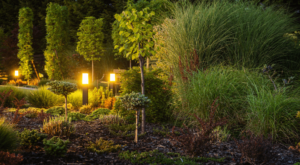
Recycled Materials and Upcycling
Sustainability hits materials too:
- Permeable Paving: From recycled plastic.
- Pallet Furniture: And reclaimed wood pieces.
- Repurposed Items: Old ladders as plant stands, tires as beds.
- Decorative Composters: Turn waste into fertilizer.
Rising Trend: “People want materials with stories, replacing generic new stuff. Unique, eco-friendly pieces are in demand.” – Landscaping & Gardening Magazine, May 2023.
Frequently Asked Questions About Residential Landscaping
How much does a residential landscaping project cost?
Costs vary by size, complexity, and materials. Basic projects start at $10/sq ft, while full designs with hardscaping can hit $160/sq ft. A typical 1,000-sq-ft yard might cost $10,000-$50,000 fully done.
Can I DIY landscaping, or should I hire a pro?
Simple projects are DIY-friendly if you know basic gardening. For pro results—especially on tricky lots or complex designs—a landscaper optimizes space, picks the right plants, and saves money long-term by avoiding errors.
When’s the best time to start a landscaping project?
Early fall (September-October in many climates) is ideal for planting, letting roots settle before summer heat. Planning can start anytime. In regions with mild seasons, projects can roll year-round.
How do I make a low-maintenance garden?
Use local or adapted plants, add automated irrigation, mulch to cut weeds and water loss, pick durable materials, and space plants to reduce frequent pruning.
What are the best plants for shady areas?
For low light, try ferns (Nephrolepis spp.), peace lilies (Spathiphyllum), pothos (Epipremnum aureum), philodendrons, begonias, anthuriums, or shade-loving heliconias. They thrive with minimal sun and keep spaces lush.
Conclusion: Transform Your Space with Residential Landscaping
Residential landscaping is more than looks—it’s an investment in your well-being, property value, and the environment. A well-designed garden becomes a personal retreat for relaxing, entertaining, and reconnecting with nature.
No matter your space or budget, there’s a landscaping solution to turn your outdoors into an oasis. Start with solid planning, choose climate-right plants, and add elements that reflect your style and needs.
A garden is a living, evolving thing. Experiment, learn from it, and tweak as you go. The journey of crafting your green haven is as rewarding as the end result.
Ready to revamp your outdoor space? Kick off your residential landscaping project today and enjoy the countless perks of a thoughtfully designed garden!
Love decorating? Check out this article on 7 kitchen decor trends for this year.
